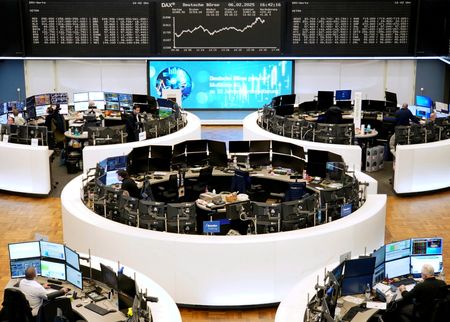By Greta Rosen Fondahn and Harry Robertson
(Reuters) – Sterling was set for its biggest one-day fall since early January on Thursday, after the Bank of England (BoE) cut interest rates and slashed its growth forecasts but warned that inflation will rise “quite sharply” this year.
Sterling was already on the back foot and extended its slide to trade about 1.1% lower at $1.2371. It was heading for its largest daily fall since January 2 and was down from a four-week high the day before.
The BoE lowered rates to 4.5% from 4.75%, but investors homed in on the fact two members of the rate-settting Monetary Policy Committee (MPC) called for a deeper 50 bps cut, one of whom had previously voted to hold rates steady.
“The fact that two MPC members voted to deliver a bumper 50 bps cut, despite revising up near term inflation forecasts, gives a sense of how concerned some policymakers are about the headwinds to growth,” said Luke Bartholomew, deputy chief economist at asset manager abrdn.
Investors initially looked past the sharp increase in the BoE’s inflation forecasts and added to their bets on rate cuts this year, seeing roughly 65 bps of further easing this year, from around 60 bps before the decision.
Britain’s two-year bond yields, which are sensitive to BoE rate expectations, fell to their lowest since October after the decision – even as U.S. and European yields rose. They later moderated to trade 3 bps lower at 4.107%.
The UK’s FTSE 100 stock index rallied and was last up at 1.65%, having traded around 1.15% higher earlier. The mid-cap index was last up 1.6%.
“The weaker than expected data coming out of the UK since the last BoE meeting has clearly encouraged them (policymakers) to be more aggressive,” said Paul Jackson, global head of asset allocation at Invesco.
He said he remained positive about UK equities and government bonds.
The BoE halved its forecast for growth this year to 0.75%, reflecting weak business and consumer sentiment and more sluggish productivity growth.
Meanwhile it said inflation, currently above target at 2.5%, is expected to peak at around 3.7% – up from a previous forecast peak of 2.8%.
“With growth under threat and inflation remaining higher than hoped, that provides a combination that is likely to see the word ‘stagflation’ being banded around,” said Neil Birrell, chief investment officer at Premier Miton Investors.
(Reporting by Greta Rosen Fondahn and Harry Robertson; Additional reporting by Naomi Rovnick; Editing by Amanda Cooper)






